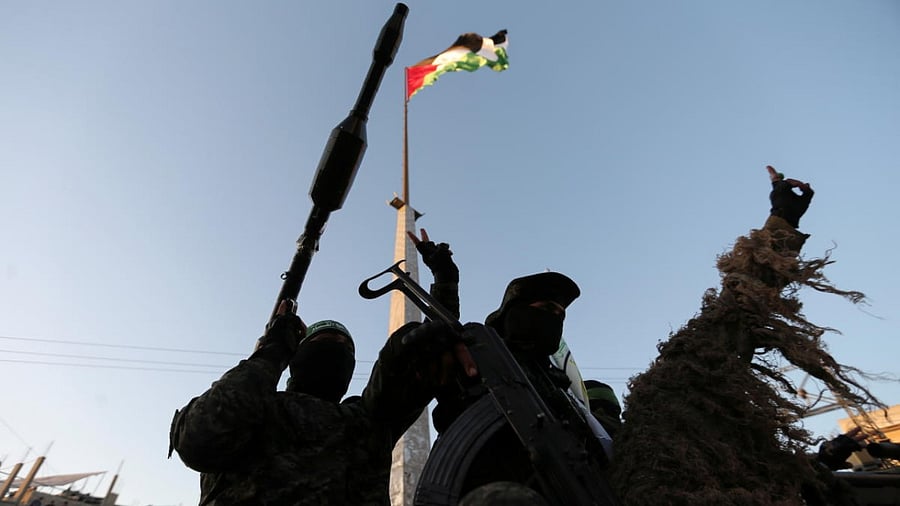
Beset by Israel's deadly attacks on Gaza, the narrow strip of Palestine-occupied territory has seen over 200 deaths and well over 1,700 have been injured. However, what has often been forgotten in the recent escalation of hostilities is that Palestine has also been battling a deadly outbreak of Covid-19.
Over the past two weeks, medical facilities that were already overwhelmed by Covid-19 saw a sudden rise in the number of hospital patients who came in with varying degrees of injuries from the relentless bombing and building collapses. This meant that hospitals were unable to cope with the onslaught of patients, power cuts and a paucity of supplies.
The Gaza Strip's land area is a small fraction of the West Bank, which means the population density there is much higher. As of May 26, according to WHO oPt (occupied Palestinian territory), Gaza currently has 2,358 active Covid-19 cases whilst the West Bank with a much higher population has 1,395 cases.
Gaza severely lacks major health infrastructure, which is widely attributed to the siege that the enclave has been under for the past 14 years. A constant blockade has heavily crippled the healthcare system where manpower is in short supply, equipment is failing due to its age and there's a shortage of essential medicines and oxygen.
“The Israel Defense Forces controls the Gaza border and controlling everything that enters Gaza," said a doctor in Gaza who asked to remain anonymous. "What (medical supplies) enters Gaza is not enough for the needs of the population here, there are two million people and what enters Gaza is not enough for even 15% of the population. Be it oxygen, ventilators or other essentials.”
He added that at the beginning of the pandemic, Gaza had only 80 ICU beds for a population of 2 million, but with the scaling up of the Covid-19 response with the help of the UN and WHO, this number has gone up.
When asked about facilities to isolate Covid-19 patients, the doctor said that those who were positive for Covid-19 were isolated in schools. However, when violence escalated, many were evacuated and returned to their homes, which resulted in contact with healthy individuals and is expected to cause a surge in Covid-19 cases in the next few weeks.
“Earlier, during the pandemic, policies such as regulations regarding social distancing measures were very vague," the doctor said. "We have many injuries, many healthcare facilities were targeted, people were in panic, they were terrified they forgot about the Covid-19 policies and all they wanted was to be in a safer place, away from the bombing.”
A UN report from May 20 notes that 72,000 Palestinians were displaced in Gaza with 58,000 seeking refuge in UNRWA schools in the Gaza Strip as of May 19. This presents hygiene risks and an inability to limit physical distance to effectively prevent Covid-19 transmission. Between May 14 and May 21, 107,000 people were internally displaced in Gaza of which 71,000 were placed in UNRWA schools and the remaining with host families. Since May 21, these displaced people started to return home. Displacement and returns pose a further risk to health security and may enhance the spread of the disease.
Between May 7 and May 20, according to a WHO report, 28 attacks on healthcare facilities were carried out in Gaza alone and 89 attacks in the West Bank. This has resulted in debilitating damage to the healthcare system of the territories. In all, 61% of primary health centres are not functioning and the remaining 39% are only partially functioning. At zero stock were 46% of essential drugs and 33% of essential medical supplies. There is a risk of an outbreak of waterborne diseases due to displacement and damage to desalination plants that used to serve 400,000 people, electricity outages and damage to water, sanitation and hygiene structures. At the time of the WHO report, Covid-19 testing was halted following damage to the main laboratory. The Ministry of Health plans to re-establish the facility.
According to the doctor, Israel had refused to vaccinate people in the Gaza Strip. The vaccines that arrived in Gaza were a part of small donations from various stakeholders. "About 100,000 doses of Sputnik V vaccine arrived in Gaza, the Covax program donated some Pfizer and AstraZeneca vaccines," the doctor said. "With the total number of vaccines we have, we cannot cover more than 150,000 to 200,000 people out of a total of 2 million people." According to Gavi, over 200,000 doses of the vaccine have been allocated for the West Bank and Gaza but only a shade over 60,000 doses have been received so far.
"Many things are needed to improve the healthcare system in Gaza," the doctor said. "A valid continuous fund is needed because healthcare professionals here are just earning 40% of their salaries and this has been the case for the last 10 years. The government is in an economic crisis and this will affect the quality of services delivered to the population. We also need to improve tools such as CT scanners, MRIs, X-rays, and equipment for examination. For example, two hospitals in Gaza have such facilities and others don’t, so cases may be transferred outside Gaza city."
Covid-19 brought Gaza’s healthcare system to its knees after it was already crippled by years of blockade, a lack of manpower and drug shortages. The recent escalation in violence only caused more strain on the system. The events that followed threaten to worsen the Covid-19 situation in the region whilst there is no end in sight to a blockade that has already endangered the lives of hundreds of thousands of residents.

